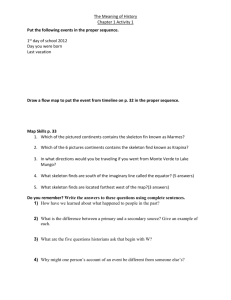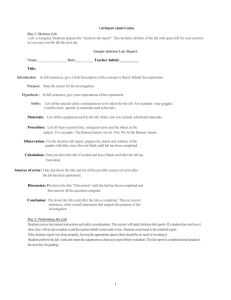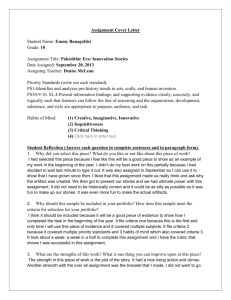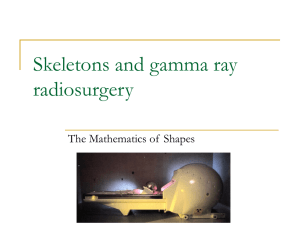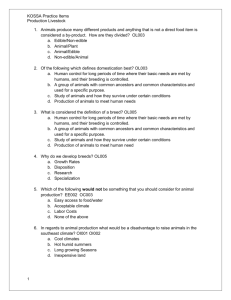1. This refers to cattle from India and descendants of the Zebu cattle
advertisement
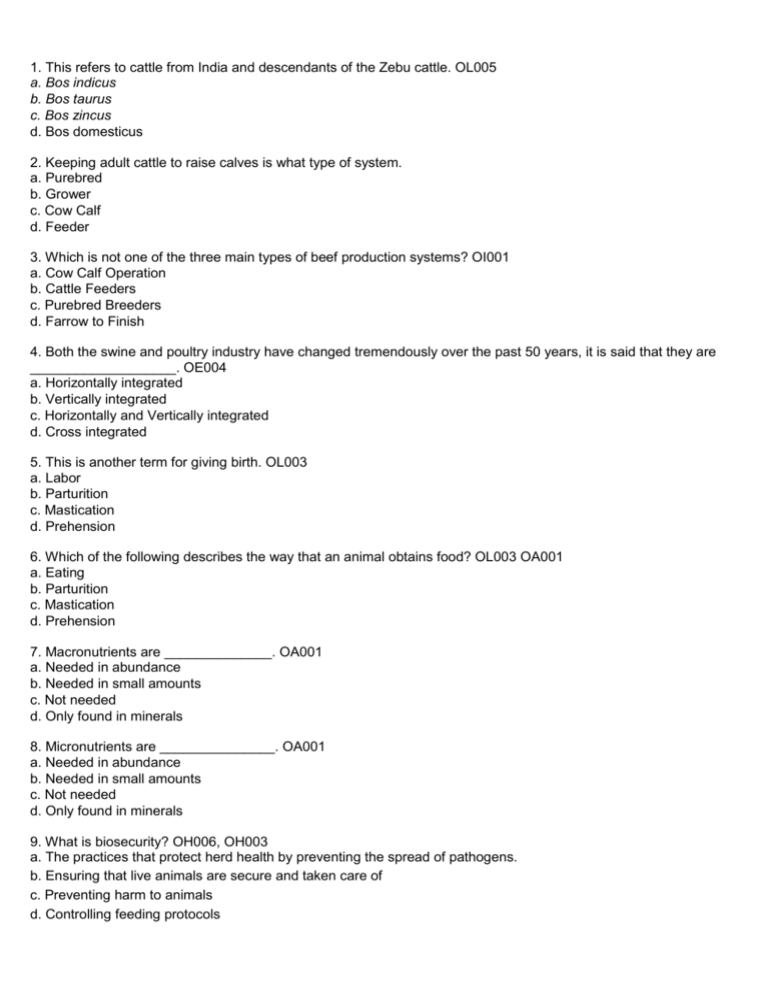
1. This refers to cattle from India and descendants of the Zebu cattle. OL005 a. Bos indicus b. Bos taurus c. Bos zincus d. Bos domesticus 2. Keeping adult cattle to raise calves is what type of system. a. Purebred b. Grower c. Cow Calf d. Feeder 3. Which is not one of the three main types of beef production systems? OI001 a. Cow Calf Operation b. Cattle Feeders c. Purebred Breeders d. Farrow to Finish 4. Both the swine and poultry industry have changed tremendously over the past 50 years, it is said that they are ___________________. OE004 a. Horizontally integrated b. Vertically integrated c. Horizontally and Vertically integrated d. Cross integrated 5. This is another term for giving birth. OL003 a. Labor b. Parturition c. Mastication d. Prehension 6. Which of the following describes the way that an animal obtains food? OL003 OA001 a. Eating b. Parturition c. Mastication d. Prehension 7. Macronutrients are ______________. OA001 a. Needed in abundance b. Needed in small amounts c. Not needed d. Only found in minerals 8. Micronutrients are _______________. OA001 a. Needed in abundance b. Needed in small amounts c. Not needed d. Only found in minerals 9. What is biosecurity? OH006, OH003 a. The practices that protect herd health by preventing the spread of pathogens. b. Ensuring that live animals are secure and taken care of c. Preventing harm to animals d. Controlling feeding protocols 10. The central nervous system consists of what two parts? OL003 OL004 a. Brain and Heart b. Spine and Muscles c. Spine and Brain d. Heart and Muscles 11. Which of the following is used in balancing rations? OA001 OF004 a. Pearson Square b. Pearson Triangle c. Pearson Circle d. Pearson Steps 12. What is a pathogen? OA002 OH002 a. Anything capable of causing disease b. A disease c. Anything capable of treating disease d. Airborne substances 13. What is an infectious disease? OA002 OH002 a. Disease caused by bacteria, protozoa, or fungi b. Disease spread from contact from animal to animal c. Disease not caused from microorganisms d. A pathogen 14. What is a contagious disease? OA002 OH002 a. Disease caused by bacteria, protozoa, or fungi b. Disease spread from contact from animal to animal c. Disease not caused from microorganisms d. A pathogen 15. What is a non-infectious disease? OA002 OH002 a. Disease caused by bacteria, protozoa, or fungi b. Disease spread from contact from animal to animal c. Disease not caused from microorganisms d. A pathogen 16. If an animal is lacking a certain nutrient it is said that the animal has a OA001 a. Toxicity problem b. Deficiency problem c. Mineral imbalance d. Vitamin imbalance 17. Balking is a term that refers to ______________________ OL003 a. Animals using habits to make decisions b. Animals stopping c. Animals pawing at the ground d. Animals following command 18. When looking to breed an animal for the first time you should look for the male to have _____________. OA004 a. Low weaning weights b. Low REA c. Low birth weights d. Low average daily gains 19. If you needed to choose hay that is high in protein you would select which of the following? OA001 a. Fescue Hay b. Mixed Grass Hay c. Timothy Hay d. Alfalfa Hay 20. Of the following choose the best placement for an injection on an animal OA002 OH006 a. Neck b. Quarter c. Side d. Under the tail 21. Shrinkage refers to ________________ OL 006 OL003 a. Loss of feed b. Loss of weight from shipping c. Loss of weight due to diet d. Loss of weight from mineral deficiencies 22. Marbling is a term that refers to fat in a specific location on the animal. Where is the fat located when this term is used? OL006 a. In the loin b. External c. Outside the muscle d. Inside the muscle 23. To prevent cannibalism in chickens producer will use this practice. OA002 a. Debeaking b. Hover guards c. Clamping d. Castration 24. For producers to continue to be successful which area is most crucial. OA004 OL003 a. Reproduction b. Feeding c. Marketing d. Vaccinating 25. Raising livestock falls under which category of the agriculture industry? OL003 a. Agricultural Supplies b. Agricultural Services c. Agricultural Processing d. Agricultural Production AC002 26. Horses have an enlarged _______ that allows for extensive microbial fermentation of a roughage diet. a. stomach b. small intestine c. rumen d. cecum . AC003 27. The length of time the fetus is in the womb is known as _____________ a. gestation b. puberty c. parturition d. ovulation OL004 28. The part of the skeleton that consists of the skull, vertebrae, and ribs is called the: a. appendicular skeleton b. dorsal skeleton c. axial skeleton d. ventral skeleton OL004 29. The part of the skeleton that consists of the fore and hind limbs is called the: a. appendicular skeleton b. dorsal skeleton c. axial skeleton d. ventral skeleton AC002 30. A livestock animal that has a 4 compartment stomach is called a: a. hindgut fermentor b. avian monogastric c. monogastric d. ruminant
